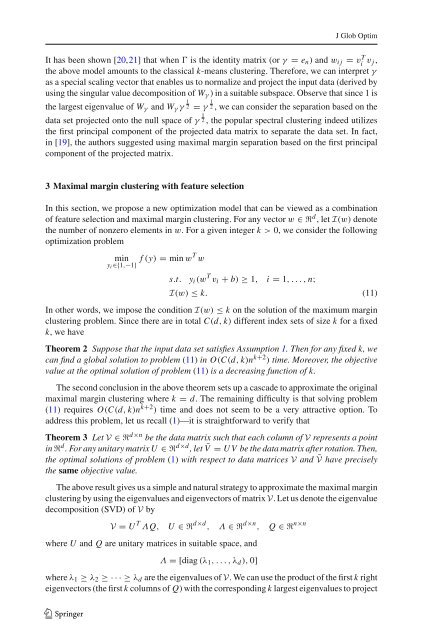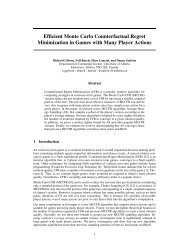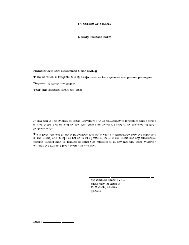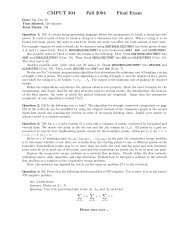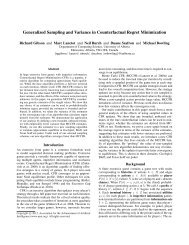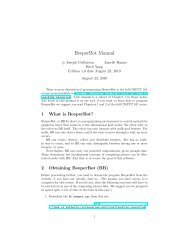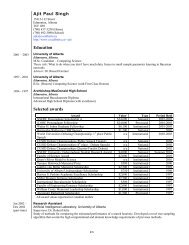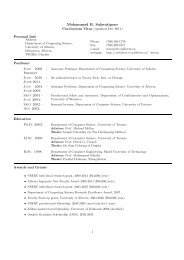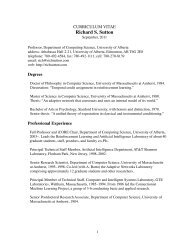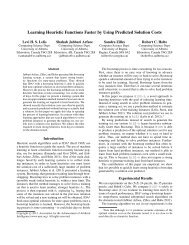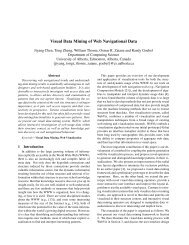An efficient algorithm for maximal margin clustering - ResearchGate
An efficient algorithm for maximal margin clustering - ResearchGate
An efficient algorithm for maximal margin clustering - ResearchGate
Create successful ePaper yourself
Turn your PDF publications into a flip-book with our unique Google optimized e-Paper software.
J Glob Optim<br />
It has been shown [20,21] that when Ɣ is the identity matrix (or γ = e n )andw ij = vi T v j ,<br />
the above model amounts to the classical k-means <strong>clustering</strong>. There<strong>for</strong>e, we can interpret γ<br />
as a special scaling vector that enables us to normalize and project the input data (derived by<br />
using the singular value decomposition of W γ ) in a suitable subspace. Observe that since 1 is<br />
the largest eigenvalue of W γ and W γ γ 2<br />
1 = γ 2 1 , we can consider the separation based on the<br />
data set projected onto the null space of γ 2 1 , the popular spectral <strong>clustering</strong> indeed utilizes<br />
the first principal component of the projected data matrix to separate the data set. In fact,<br />
in [19], the authors suggested using <strong>maximal</strong> <strong>margin</strong> separation based on the first principal<br />
component of the projected matrix.<br />
3 Maximal <strong>margin</strong> <strong>clustering</strong> with feature selection<br />
In this section, we propose a new optimization model that can be viewed as a combination<br />
of feature selection and <strong>maximal</strong> <strong>margin</strong> <strong>clustering</strong>. For any vector w ∈R d ,letI(w) denote<br />
the number of nonzero elements in w. For a given integer k>0, we consider the following<br />
optimization problem<br />
min<br />
y i ∈{1,−1} f(y) = min wT w<br />
s.t. y i (w T v i + b) ≥ 1, i = 1,...,n;<br />
I(w) ≤ k. (11)<br />
In other words, we impose the condition I(w) ≤ k on the solution of the maximum <strong>margin</strong><br />
<strong>clustering</strong> problem. Since there are in total C(d,k) different index sets of size k <strong>for</strong> a fixed<br />
k, wehave<br />
Theorem 2 Suppose that the input data set satisfies Assumption 1. Then <strong>for</strong> any fixed k,we<br />
can find a global solution to problem (11) in O(C(d,k)n k+2 ) time. Moreover, the objective<br />
value at the optimal solution of problem (11) is a decreasing function of k.<br />
The second conclusion in the above theorem sets up a cascade to approximate the original<br />
<strong>maximal</strong> <strong>margin</strong> <strong>clustering</strong> where k = d. The remaining difficulty is that solving problem<br />
(11) requires O(C(d,k)n k+2 ) time and does not seem to be a very attractive option. To<br />
address this problem, let us recall (1)—it is straight<strong>for</strong>ward to verify that<br />
Theorem 3 Let V ∈R d×n be the data matrix such that each column of V represents a point<br />
in R d . For any unitary matrix U ∈R d×d ,let ¯V = UV be the data matrix after rotation. Then,<br />
the optimal solutions of problem (1) with respect to data matrices V and ¯V have precisely<br />
the same objective value.<br />
The above result gives us a simple and natural strategy to approximate the <strong>maximal</strong> <strong>margin</strong><br />
<strong>clustering</strong> by using the eigenvalues and eigenvectors of matrix V. Let us denote the eigenvalue<br />
decomposition (SVD) of V by<br />
V = U T ΛQ, U ∈R d×d , Λ ∈R d×n , Q ∈R n×n<br />
where U and Q are unitary matrices in suitable space, and<br />
Λ =[diag (λ 1 ,...,λ d ), 0]<br />
where λ 1 ≥ λ 2 ≥···≥λ d are the eigenvalues of V. We can use the product of the first k right<br />
eigenvectors (the first k columns of Q) with the corresponding k largest eigenvalues to project<br />
123


